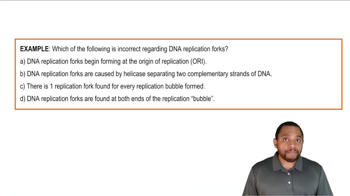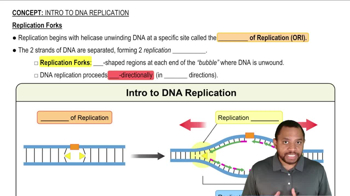Here are the essential concepts you must grasp in order to answer the question correctly.
DNA Replication
DNA replication is the biological process by which a cell duplicates its DNA, ensuring that each new cell receives an exact copy of the genetic material. This process involves several key enzymes and proteins that work together to unwind the DNA double helix, synthesize new strands, and proofread the newly formed DNA to maintain genetic fidelity.
Recommended video:
Intro to DNA Replication Example 2
Helicase
Helicase is an essential enzyme in DNA replication that unwinds the double-stranded DNA helix, separating the two strands to allow access for other enzymes involved in the replication process. By breaking the hydrogen bonds between the nucleotide bases, helicase creates two single-stranded templates that can be copied into new DNA strands.
Recommended video:
Intro to DNA Replication Concept 3
Enzyme Function
Enzymes are biological catalysts that speed up chemical reactions in living organisms. In the context of DNA replication, helicase's function is crucial as it facilitates the unwinding of DNA, which is a necessary step for the replication machinery to synthesize new DNA strands efficiently. Without helicase, the replication process would be significantly slower and less efficient.
Recommended video:
 Verified step by step guidance
Verified step by step guidance Verified video answer for a similar problem:
Verified video answer for a similar problem:



 5:8m
5:8m